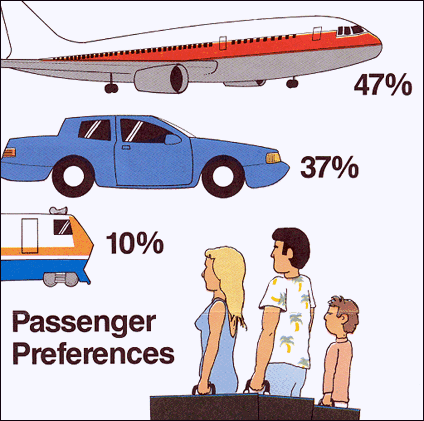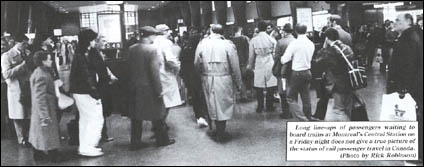Vol. 17 No. 12
December, 1987
|
Stay Safe in 87
|
|
Passenger Train Service a "Catch 22"
Situation

Although successive
surveys have shown
that a large majority of Canadians want rail passenger services to survive, 47 percent of them polled in 1985 said
they preferred air travel. Another 37 percent said they preferred to travel by car. Only 10 percent said they'd
rather take the train.
Montreal - It's a Friday evening, the beginning of a long weekend.
Travellers - hundreds of them - many with kids in tow, struggle with their bags and line up at VIA Rail's departure
gates in Montreal's cavernous Central Station.
The place is packed. Queues stretch the length of the station. VIA representatives scurry like worker bees, checking
tickets, answering questions, directing traffic, all the while maintaining their cool. Sweating redcaps gingerly push
their way through the crowds, their carts laden with baggage.
From all appearances, business for VIA looks very good, indeed. But the crowded station on this Friday evening
doesn't tell the whole story.
The hard reality is that, despite weekend surges in places such as Montreal and Toronto, the rail passenger is an
endangered species.
ENDANGERED SPECIES
The handwriting was on the wall as long ago as the 1950s. CP Rail in particular made a massive effort to get the
railway passenger off the endangered species list with the investment in "The Canadian" and the Dayliner
fleet. It didn't work. Similar efforts by CN were likewise unsuccessful.
Today, after a period in the 70s when the railways were subsidized to carry passengers, CP Rail is no longer a
railway passenger carrier.
But it is, although less directly, still involved in the passenger business - as a supplier of trackage and some
operating personnel to VIA.
VIA is a customer of CP Rail - but not in the usual commercial sense, because both the railways and VIA labour under
the conflict of two very different mandates.
On the one hand are the railways' needs, as businesses, to recover the costs of what they provide VIA. On the other
is the reality that VIA comes nowhere near covering its costs, even if the railways received nothing for the use of
their trackage.
CROWN-OWNED
Supervising the uneasy relationship between the railways and VIA is the federal government which created the
Crown-owned passenger service. Many observers see Ottawa as caught in the middle - between pressures to
keep passenger trains running and pressures to hold the line on taxes.
For someone like E.A. Moule, CP Rail's general manager, grain and passenger service, understanding those balances
goes with his job. But he says some hard choices are necessary if Canadians truly want passenger services to survive.
PROFITABILITY GONE
"For many years, passenger trains were a profitable business. But those days are gone. Rail passenger service
is a victim of social and technological change", he said during an interview with CP Rail News.
Cars, busses, and planes have cut deeply into a field that was once the almost-exclusive preserve of the
passenger train.
"You can't make a one-day trip from Toronto to Winnipeg by train to put in a day of business. And
business always was the mainstay of passenger train traffic - and of dining car and sleeping car service", Mr.
Moule said.
Today, all that remains of the once proud and once romantic Canadian passenger train service are busy weekend traffic
on some corridors, some mid-week travel on the same corridors and seasonal demand for
once-in-a-lifetime land cruises.
"Unfortunately busy Friday nights and Sunday afternoons cannot make up for the passenger traffic loss which
passenger trains suffered during the regular business week", he said.
INADEQUATE REVENUE
VIA Rail pays the railways to operate trains over their track. The amount VIA pays has been a sore spot with many who
believe if those costs were reduced or removed, VIA would have a fighting chance. Not so, says Mr. Moule.
"One thing is certain, the relatively modest - and we believe inadequate - contribution VIA makes toward its
share of the upkeep of the railway roadway does not alter the fundamentals of VIA's health", he said.
"The fact is that, even if VIA made absolutely no contribution at all to the maintenance of the railway roadway,
its revenue from ticket sales would still cover barely one third of its operating expenses".
Mr. Moule says CP Rail believes VIA should make a fair contribution - in much the same way the railway believes all
modes of transportation should bear a fair share of the costs of the infrastructure they use.
An added problem is what Mr. Moule terms "the confused environment of public opinion" concerning passenger
trains. That opinion, he says, is based more on sentiment than reality.
"There will always be people who insist they like trains and want to use them for some of their travel when time
permits - but it seldom does".
PLANES PREFERRED
Although successive surveys have shown that a large majority of Canadians want rail passenger service to survive,
47 percent of Canadians polled in 1985 said they preferred air travel, and 37 percent said they preferred to travel
by car. Only 10 percent said they'd rather take the train.
To quote Pierre Franche, VIA's former president: Canadian "value passenger rail even if, paradoxically,
they don't use it as much as we would like".
It's a classic "Catch 22" situation.
"Clearly", says Mr. Moule, "there are places where rail passenger service probably is necessary in
Canada. One place is southern Ontario, where many new rail passenger services in the form of commuter trains, have
been put in place - reaching farther and farther out from the center of Toronto".
But, in the final analysis, Mr. Moule says public policy will have to recognize the real costs of rail passenger
services "and make hard choices about which of these services are to be provided and in what
ways".

This CP Rail News article is copyright
1987 by the Canadian Pacific Railway and is reprinted here with
their permission. All photographs, logos, and trademarks are the property of the Canadian Pacific Railway
Company.
|